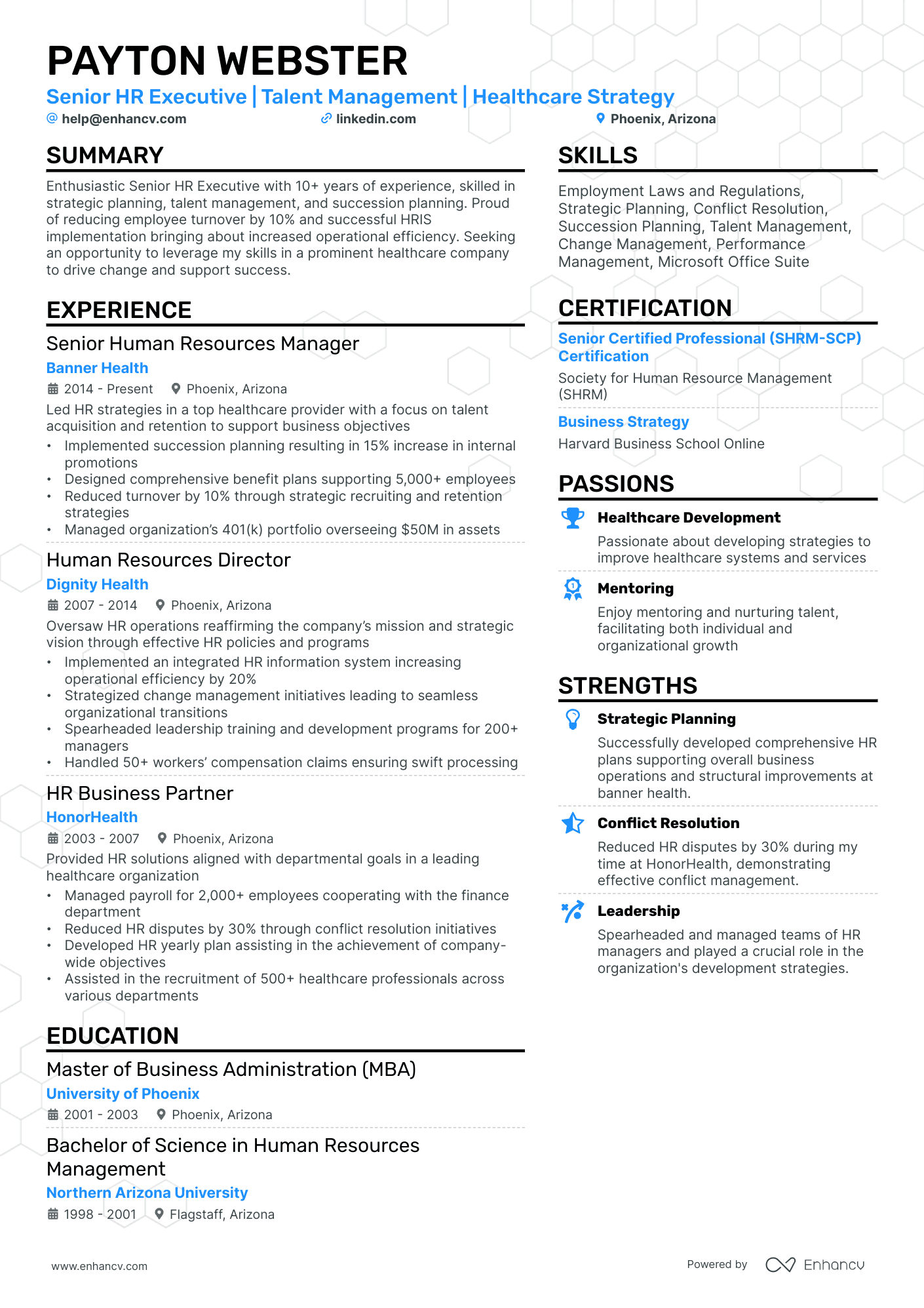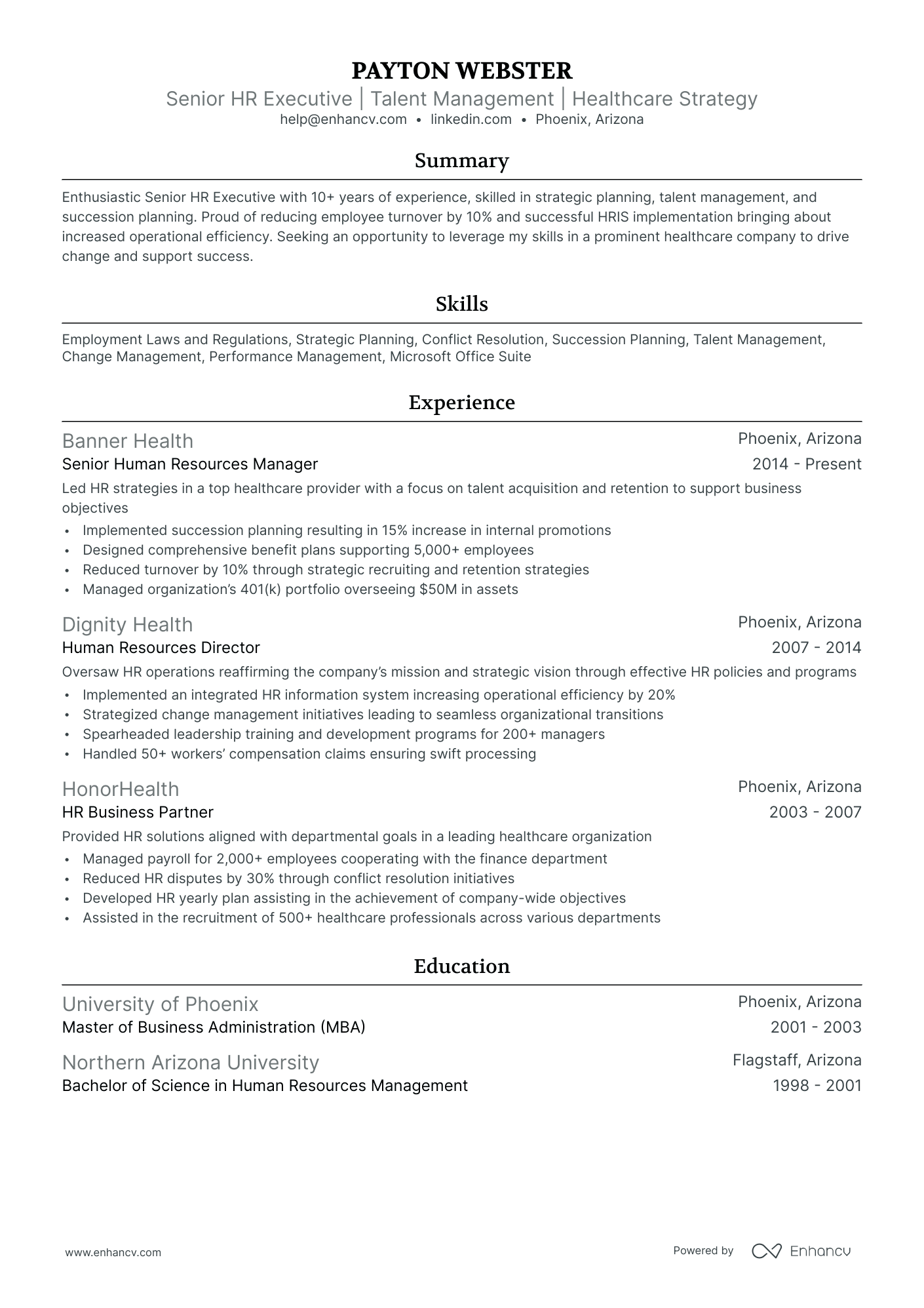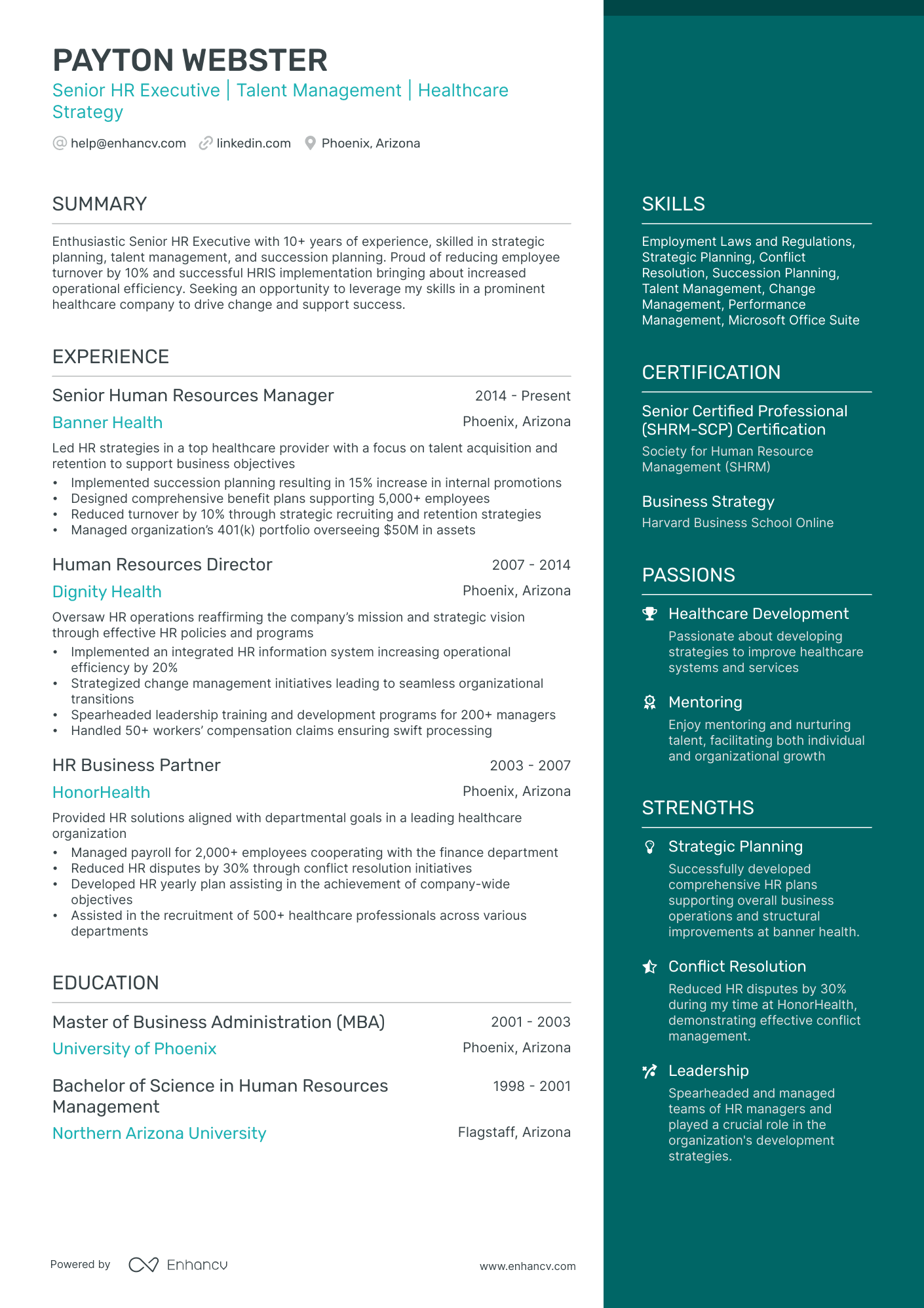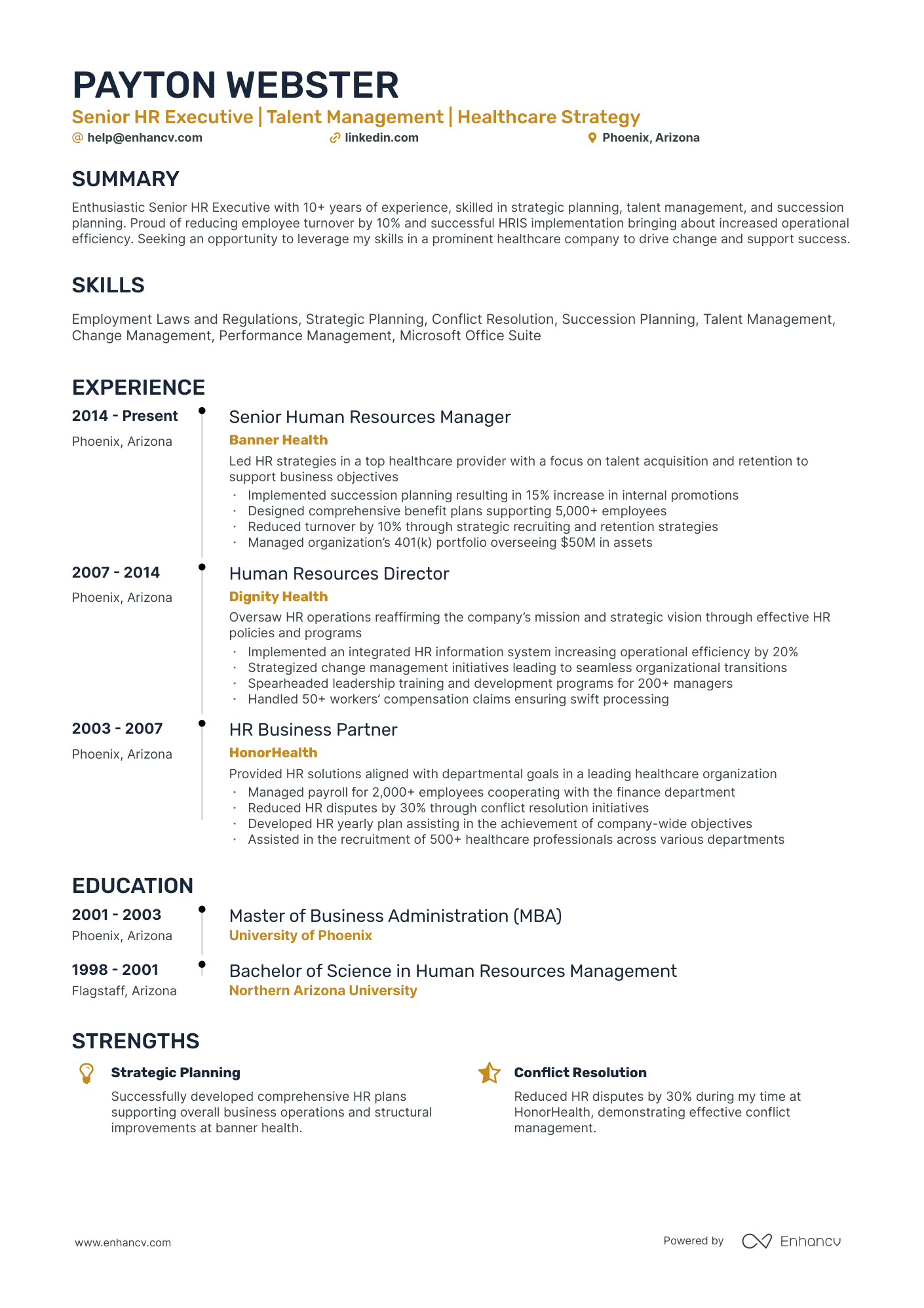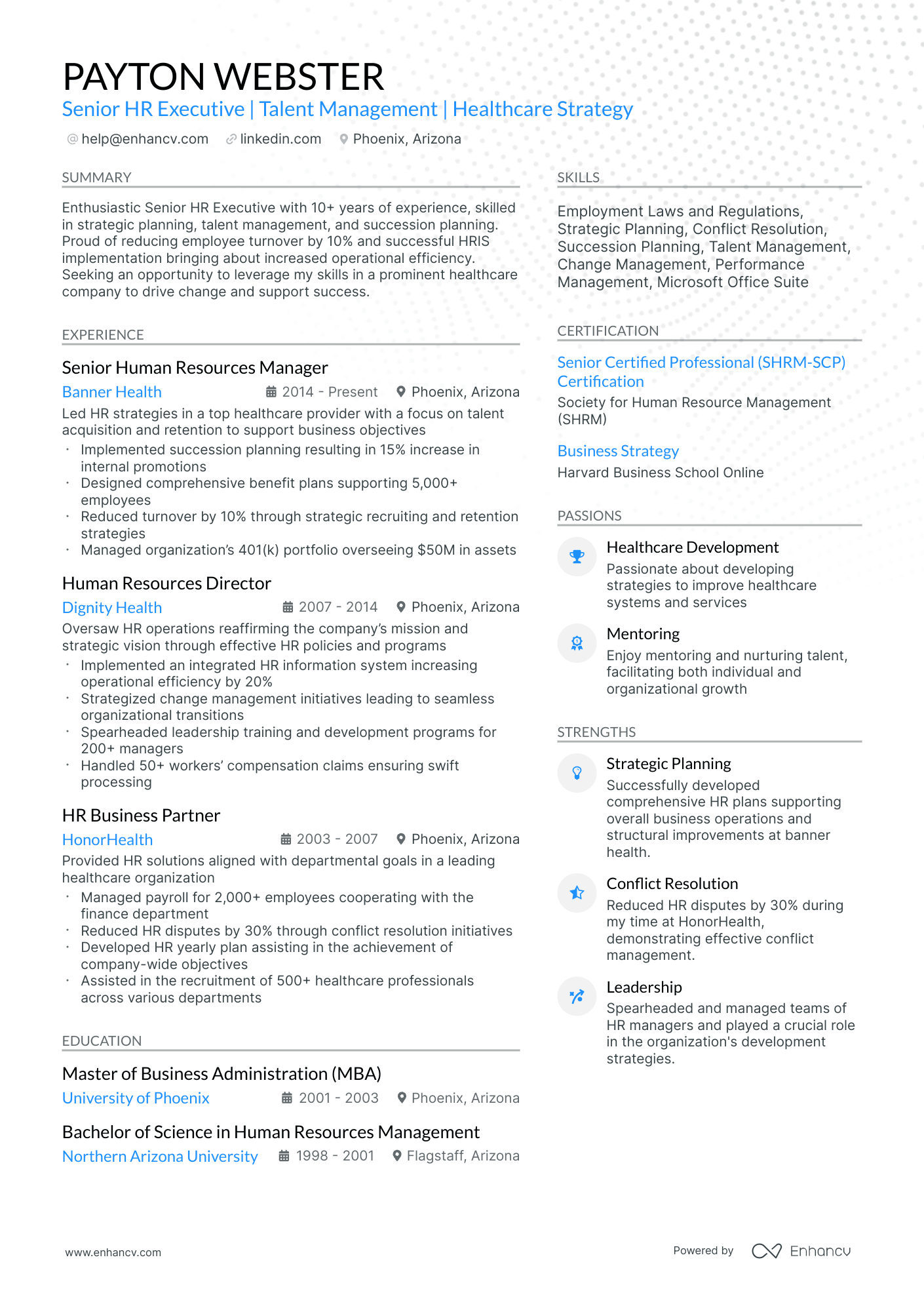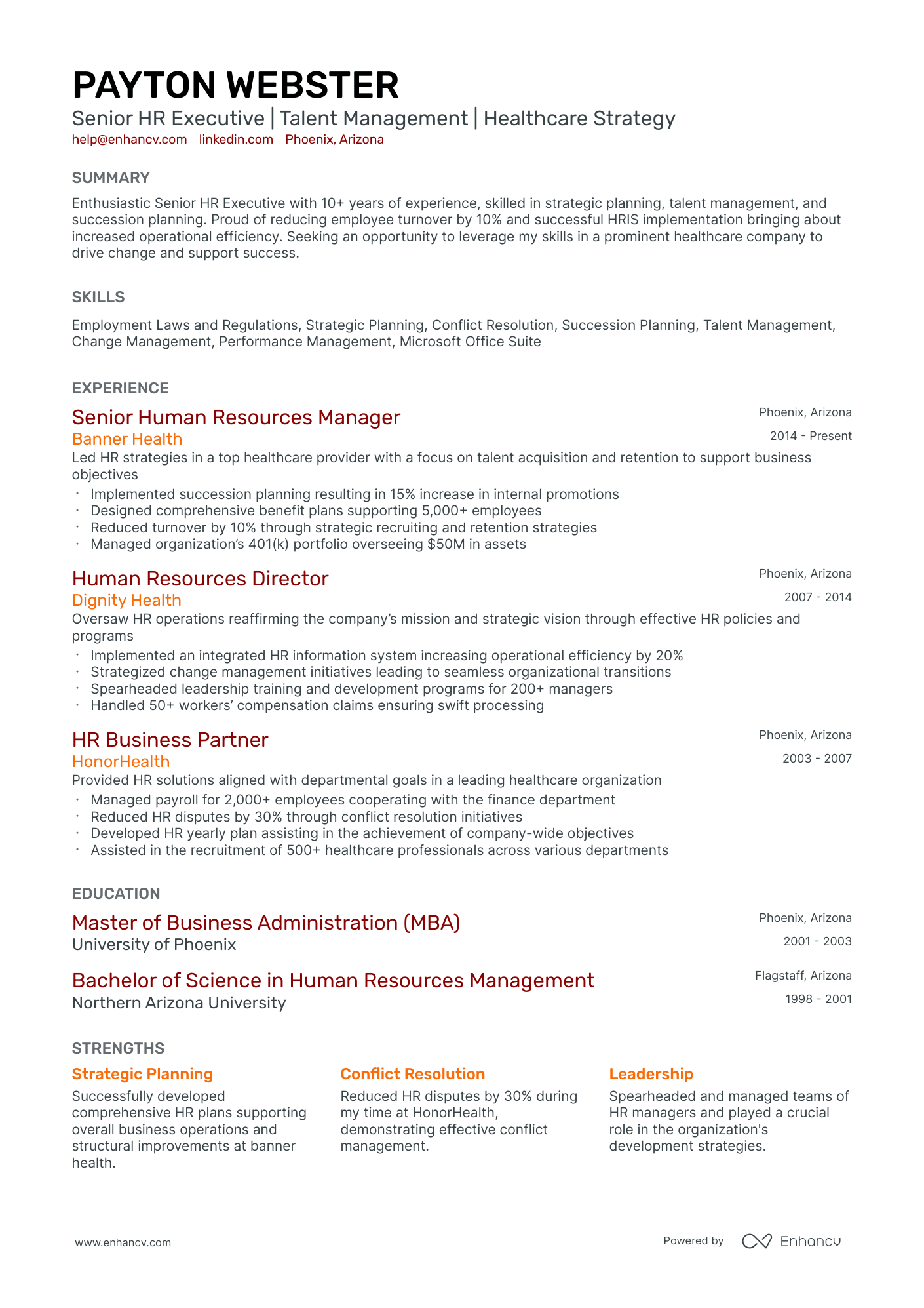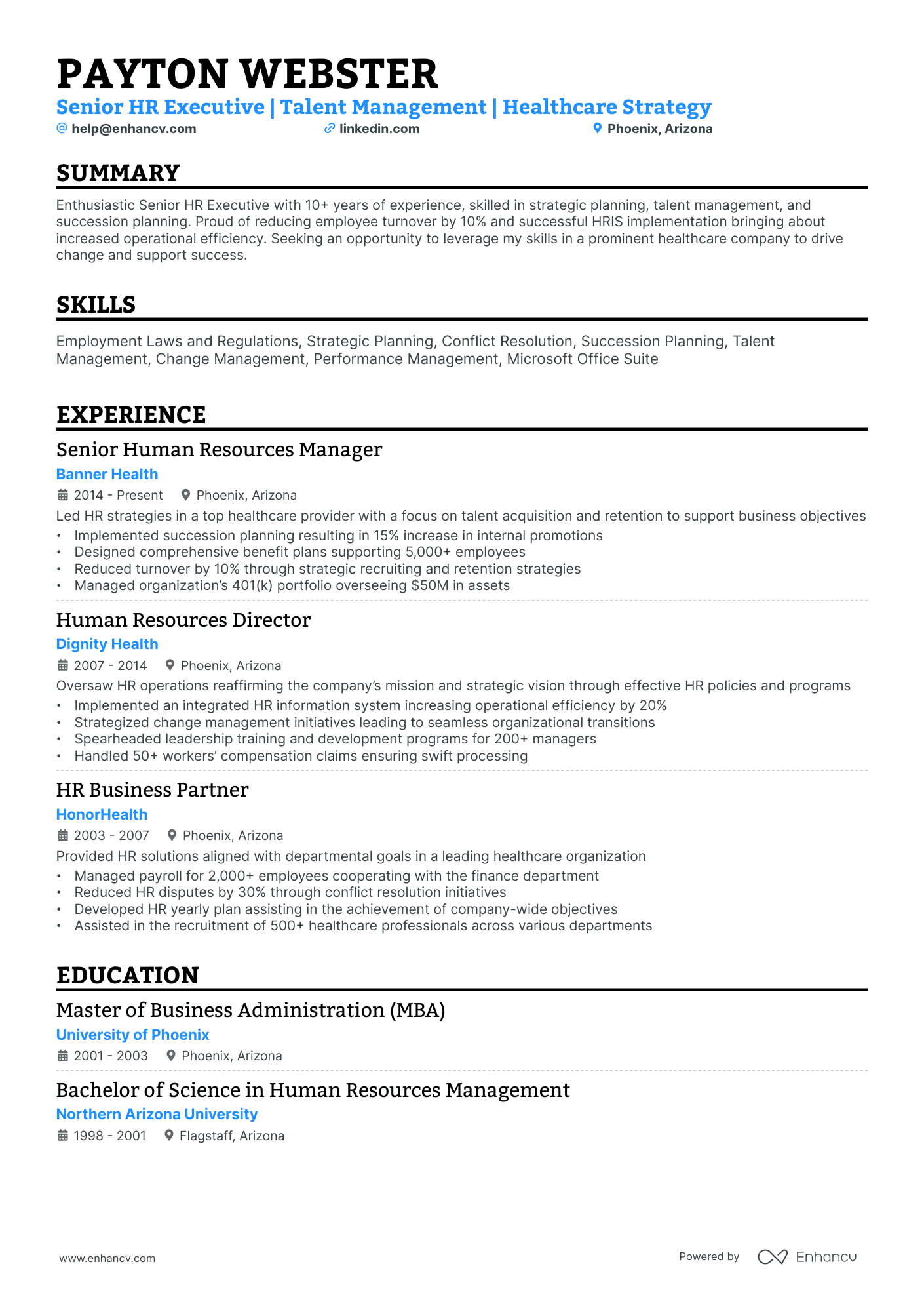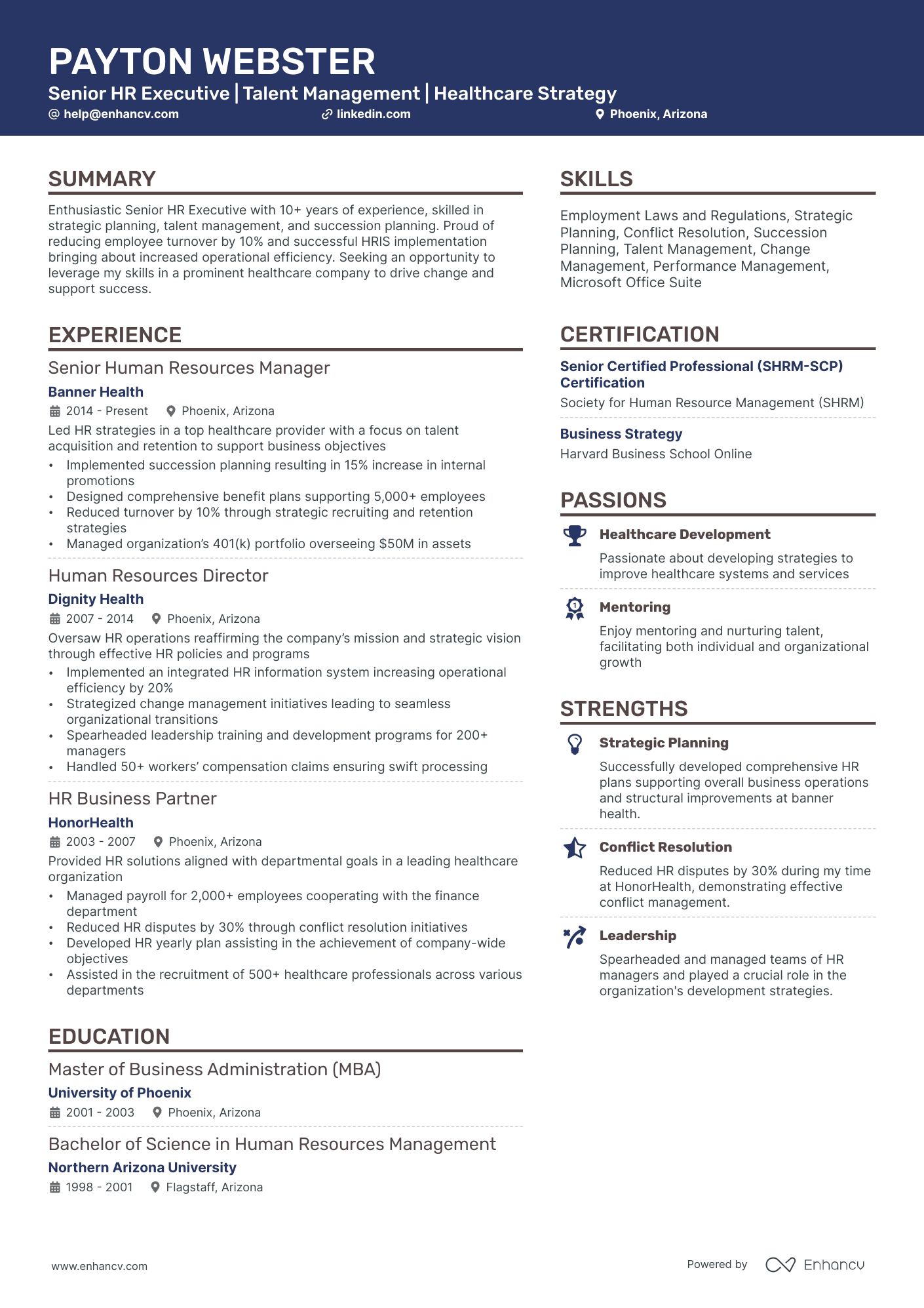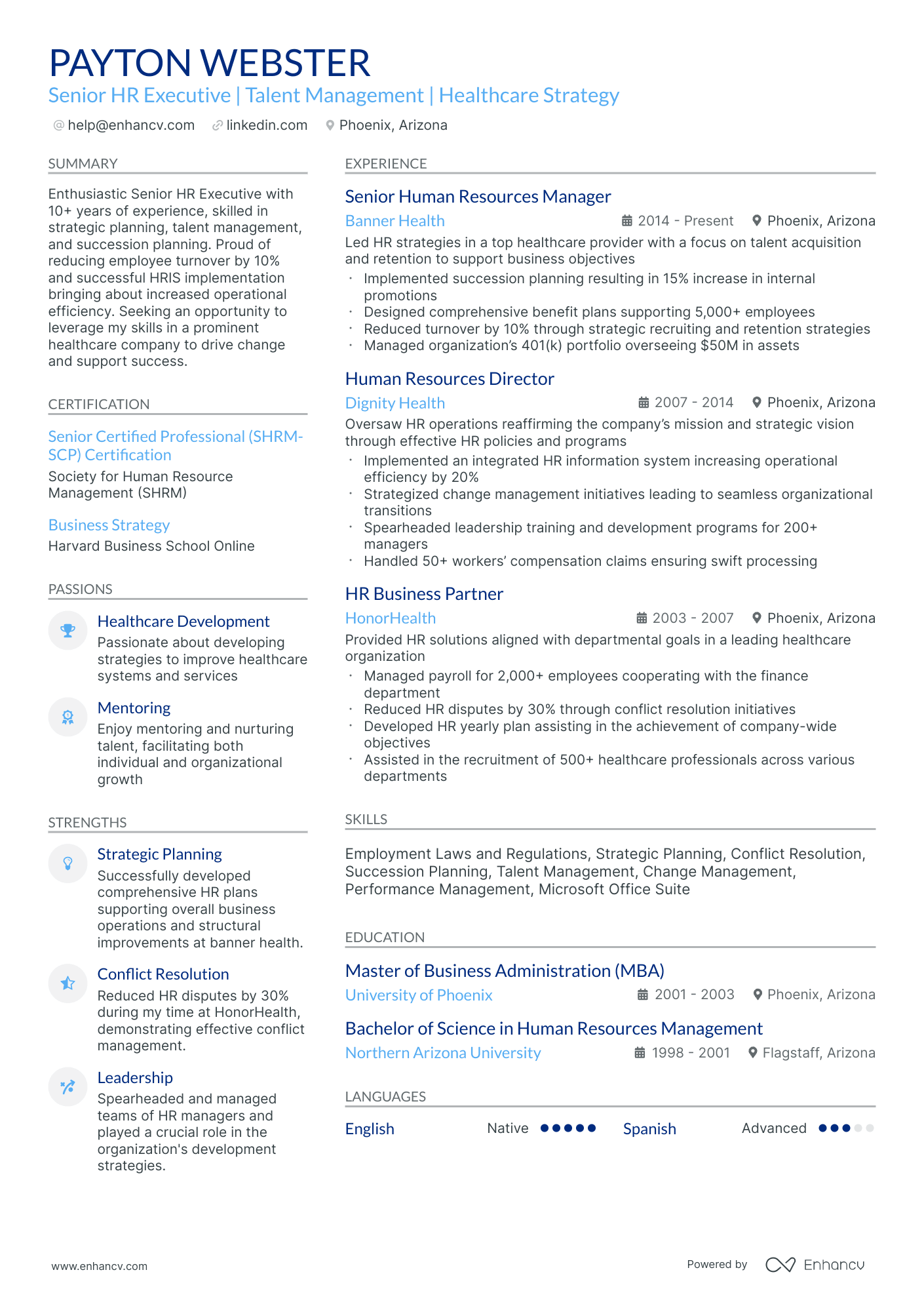A common resume challenge for a chief human resources officer (CHRO) can be effectively summarizing and quantifying the broad range of strategic initiatives they've led, especially those driving organizational change and development. Our guide provides step-by-step instructions on how to articulate these achievements in concise, impactful statements, using measurable results where possible to highlight their key contributions to business growth and performance.
Our chief human resources officer guide will help you perfect your resume by explaining you how to:
- Alight your chief human resources officer resume with the role you're applying for ensuring it will be read by the applicant tracking system.
- Tailor your specific chief human resources officer experience to get the attention of recruiters.
- List your relevant education to impress hiring managers.
- Discover job-winning chief human resources officer professional resume examples to inspire writing yours.
Recommended reads:
Structuring your chief human resources officer resume to engage recruiters
The presentation of your chief human resources officer resume is crucial.
Is it easy to read and well-organized? Does it have a logical flow?
Avoid overwhelming recruiters with a cluttered document. Instead, follow these best practices to ensure a consistent resume format:
- Include a header in the top third of your chief human resources officer resume for easy contact and quick access to your professional portfolio or LinkedIn profile.
- In the experience section, start with your most recent role and detail your career in a reverse-chronological order.
- Unless specified, submit your resume as a PDF to maintain its layout. Some companies might request other formats.
- If you're applying for a senior position and have over a decade of relevant experience, a two-page chief human resources officer resume is acceptable. Otherwise, aim for a single page.
Upload your resume
Drop your resume here or choose a file. PDF & DOCX only. Max 2MB file size.
Pro tip
At the end of the day, recruiters care most about how easily they can scan and read your resume layout. Unless you're aiming for a role in a creative field, it might be best to stick with a straightforward layout and format. Instead, put your energy into showcasing your experience.
Don't forget to include these six sections on your chief human resources officer resume:
- A header for your contact details and a summary that highlight your alignment with the chief human resources officer job you're applying for
- An experience section that explains how you apply your technical and personal skills to deliver successful results
- A skills section that further highlights how your profile matches the job requirements
- An education section that provides your academic background
- An achievements' section that mentions any career highlights that may be impressive, or that you might have missed so far in other resume sections
What recruiters want to see on your resume:
- Strategic leadership: Evidence of leading and implementing HR strategies aligned with the overall business goals.
- Talent management: Proven experience in talent acquisition, development, and retention, showing an understanding of how to shape a high-performing workforce.
- Change management: Ability to manage organizational change, including mergers, acquisitions, or significant restructuring events, effectively and sensitively.
- Data-driven decision making: Track record of using data analytics for strategic human resource planning and decision-making.
- Cultural competency: Experience in fostering a diverse and inclusive workplace culture, and addressing employee engagement issues across multiple regions or countries (if needed).
Recommended reads:
Optimizing your chief human resources officer resume experience section
Your resume's experience section should resonate with your accomplishments while aligning with the job's demands. Here's how:
- Highlight significant career moments, and back them up with relevant skills.
- Analyze the job description to address both basic and advanced requirements.
- If you have unrelated roles, consider a separate section, but emphasize transferable skills.
- Avoid listing roles from over a decade ago unless they showcase your trajectory, especially for senior roles.
- Illustrate how your contributions enhanced the team or company, linking challenges to solutions.
Review how seasoned chief human resources officer professionals have crafted their experience sections, emphasizing their contributions.
- Led the development and implementation of a comprehensive talent acquisition strategy resulting in a 30% increase in quality hires.
- Implemented an employee engagement program that improved overall satisfaction by 20% within the first year.
- Collaborated with senior leadership to design and execute a company-wide diversity and inclusion initiative, driving a 15% increase in workforce diversity.
- Managed a team of HR professionals and provided coaching and guidance on performance management and professional development.
- Developed and implemented policies and procedures to ensure compliance with local labor laws and industry regulations.
- Revamped the compensation and benefits structure resulting in a 10% decrease in turnover rate.
- Created and executed a training program for managers on effective performance feedback, resulting in a 25% improvement in employee performance.
- Designed and implemented an HR analytics dashboard, providing actionable insights on workforce trends and improving decision-making processes.
- Led organizational change initiatives, including restructuring and reorganization efforts, resulting in increased operational efficiency.
- Managed employee relations issues, conducted investigations, and developed resolutions to maintain a positive and productive work environment.
- Developed and implemented a comprehensive talent management strategy resulting in a 20% reduction in time-to-fill critical positions.
- Oversaw the design and implementation of a company-wide performance management system, resulting in a 15% increase in employee productivity.
- Led negotiations with labor unions, resulting in successful contracts that balanced company needs and employee interests.
- Developed and conducted training programs on compliance, diversity, and inclusion, ensuring legal and ethical standards were met.
- Managed HR budget and resources, optimizing cost efficiency while meeting organizational needs.
- Implemented a streamlined recruitment process that reduced time-to-hire by 30% and improved candidate experience.
- Developed and executed an employee retention program resulting in a 25% decrease in voluntary turnover.
- Supported leadership in identifying skill gaps and implementing targeted training initiatives to address development needs.
- Managed labor relations and ensured compliance with collective bargaining agreements and employment laws.
- Initiated a company-wide wellness program, resulting in a 10% decrease in employee absenteeism.
- Developed and executed a talent acquisition strategy that increased the hiring of diverse candidates by 40%.
- Led a workforce planning initiative resulting in optimized staffing levels and cost savings of $500,000 annually.
- Implemented a performance management system that aligned individual goals with organizational objectives, resulting in a 15% improvement in overall performance.
- Provided guidance and coaching to managers on employee relations issues, resulting in a 20% reduction in formal grievances.
- Collaborated with cross-functional teams to design and deliver leadership development programs.
- Developed and executed a comprehensive diversity and inclusion strategy, resulting in a 25% increase in underrepresented talent.
- Led the implementation of an HRIS system, improving data accuracy and streamlining HR processes.
- Designed and facilitated management training programs on effective conflict resolution and team building.
- Managed organizational restructuring efforts, including workforce planning and talent redeployment.
- Supported the development and communication of company policies and procedures to ensure compliance and consistency.
- Developing and executing strategic HR initiatives aligned with business goals to support growth and innovation.
- Leading talent acquisition efforts to attract top talent and drive recruitment strategies for critical positions.
- Designing and implementing performance management systems to align individual and team goals with the company's objectives.
- Overseeing employee relations, conducting investigations, and resolving complex issues to maintain a positive work environment.
- Managing compensation and benefits programs to ensure competitive offerings and support employee retention.
- Implemented an innovative employee engagement program resulting in a 20% improvement in overall job satisfaction.
- Developed and delivered training programs on leadership development and effective communication.
- Led the implementation of a new HRIS system, improving data accuracy and efficiency in HR operations.
- Managed corporate restructuring initiatives, including workforce planning and talent redeployment.
- Provided guidance and coaching to managers on employee performance management and development.
- Implemented a comprehensive employer branding strategy resulting in a 30% increase in qualified applicants.
- Led the design and execution of leadership development programs, enhancing the company's leadership pipeline.
- Developed and implemented an employee recognition program that improved employee satisfaction by 25%.
- Managed complex employee relations issues, conducted investigations, and implemented resolutions.
- Collaborated with cross-functional teams to ensure compliance with labor laws and industry regulations.
- Managed end-to-end recruitment processes, ensuring timely hiring of qualified candidates.
- Designed and delivered training programs on diversity and inclusion, unconscious bias, and harassment prevention.
- Supported organizational restructuring efforts, including job redesign and workforce realignment.
- Developed and implemented HR policies and procedures to ensure compliance and consistency.
- Provided HR-related advice and counsel to senior leadership and managers.
Quantifying impact on your resume
<ul>
No experience, no problem: writing your chief human resources officer resume
You're set on the chief human resources officer role of your dreams. Yet, you have little to no work experience . Here's how you can curate your resume to substitute your lack of experience:
- Don't list every single role you've had so far, but focus on the ones that align with the job you're applying for
- Include any valid experience in the field - whether it's a university research project, or a summer internship
- Highlight the soft skills you're bringing along - those that will have an added value to your application.
- Focus on your education and certifications, especially if they make sense for the role.
Recommended reads:
Pro tip
Use the SOAR (Situation - Action - Results) method for each of your chief human resources officer experience bullets. Reflect on specific challenges you've addressed, the actions you took, and the outcomes. This approach also preps you for potential interview questions.
Essential chief human resources officer hard and soft skills for your resume
Recruiters evaluate not just your professional history, but also how your skills resonate with the job's requirements.
Your skills are categorized into:
- Hard or technical skills: These reflect your proficiency in specific tasks or technologies.
- Soft skills: These pertain to your interpersonal abilities and how you adapt to various situations.
When crafting your resume, ensure you:
- Highlight five to six skills that directly align with the job description.
- Integrate industry-specific keywords while also emphasizing your unique strengths.
- Support your skills with an achievements section, detailing tangible outcomes.
- Quantify your proficiency wherever possible, rather than merely listing skills.
To help you, we've curated a list of the most sought-after hard and soft skills for chief human resources officer roles.
Top skills for your chief human resources officer resume:
HRIS (Human Resource Information Systems)
Applicant Tracking Systems (ATS)
Performance Management Software
Payroll Systems
Learning Management Systems (LMS)
Employee Engagement Tools
Data Analytics Tools
Compensation Management Software
Compliance Management Tools
Talent Management Software
Leadership
Strategic Thinking
Communication
Conflict Resolution
Emotional Intelligence
Change Management
Negotiation
Problem-Solving
Team Building
Adaptability
Pro tip
If the job emphasizes team or organizational culture, dedicate a section of your resume to underscore your strengths and achievements. Top-tier chief human resources officer candidates also highlight their alignment with a company's values and culture.
How to properly list your resume's education and certifications
Don't underestimate the importance of your resume education section , as it oftentimes helps you further tailor your resume to the job ad.
When writing your education section:
- Include the most relevant degree you have with information about the institution and dates of start and completion;
- If you're in the process of obtaining your degree, include your expected graduation date;
- Consider leaving off degrees that aren't relevant to the job or industry;
- Add bullet points to show how you gained valuable experience relevant for the job in an academic environment.
When describing your resume certifications , always consider their relevancy to the role.
Use the same format to describe them as you will for your education. If you're wondering what are the best certificates for chief human resources officer roles, check out the list below.
Best certifications to list on your resume
Pro tip
If you have plenty of certifications, prioritize the most relevant and industry-recognized ones. Arrange them based on their relevance to the job at hand.
Recommended reads:
Choosing between a resume summary or objective
Many chief human resources officer candidates ponder whether to include a resume summary or objective.
Here's a breakdown:
- A Resume objective outlines your career aspirations. It tells recruiters why you're applying and the value you can bring.
- A Resume summary offers a snapshot of your significant achievements, giving a quick overview of your expertise.
New professionals might lean towards an objective, while seasoned experts might prefer a summary. Whichever you choose, ensure it's tailored to the role.
For inspiration, review examples from established chief human resources officer professionals.
Resume summary and objective examples for a chief human resources officer resume
Enhancing your chief human resources officer resume with additional sections
Make your chief human resources officer resume truly distinctive by adding supplementary sections that showcase:
- Awards that underscore your industry recognition.
- Projects that bolster your application's relevance.
- Hobbies, if they can further your candidacy by revealing facets of your personality.
- Community involvement to highlight causes you champion.
Key takeaways
- Format your chief human resources officer resume for clarity and coherence, ensuring it aligns with the role.
- Highlight key sections (header, summary/objective, experience, skills, certifications) within your chief human resources officer resume.
- Quantify achievements and align them with skills and job requirements.
- Feature both technical and personal skills across your resume for a balanced portrayal.
